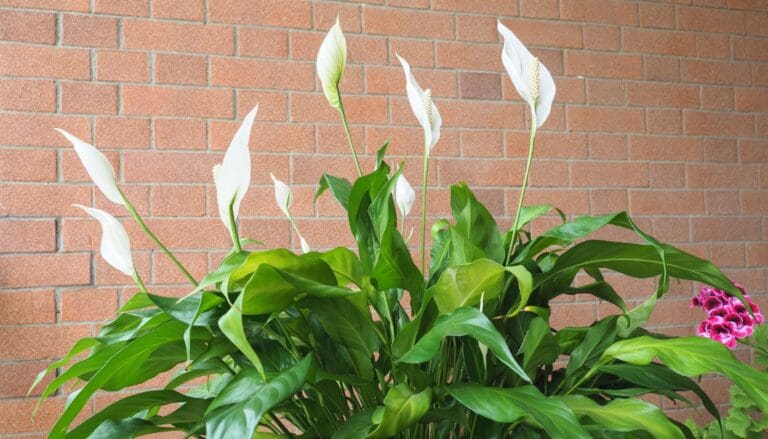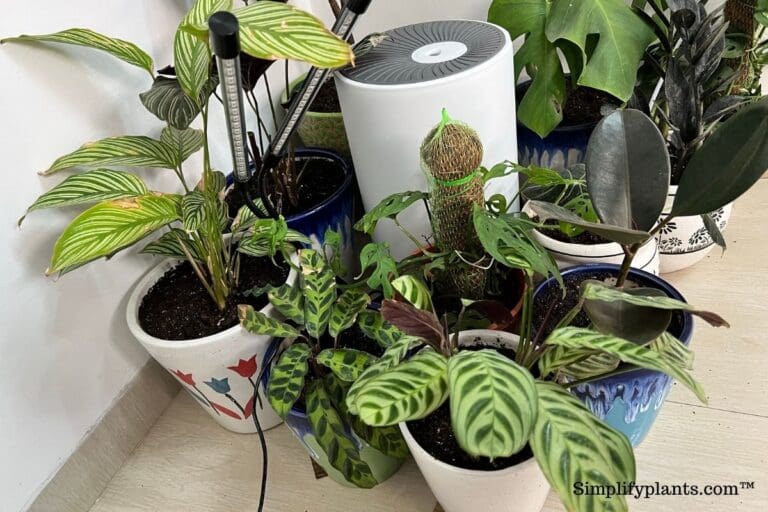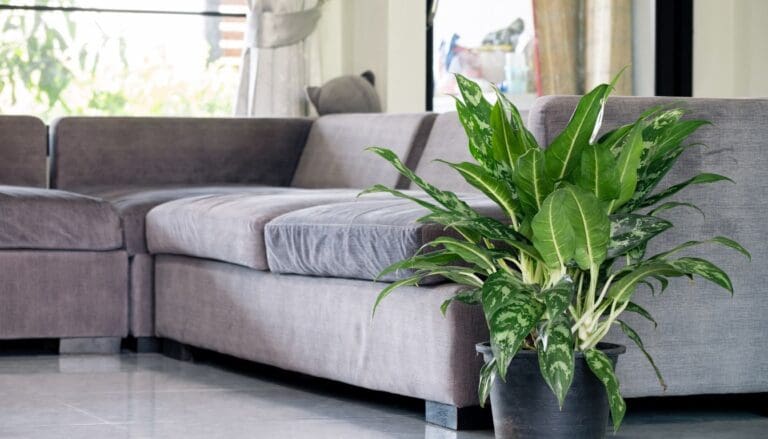What Kind Of Light Does A Croton Need? (Croton Light Requirements )
A good amount of light plays a vital role in the growth and development of a plant. For Crotons, light is of utmost importance. With the right kind and amount of light, Crotons will thrive as a houseplant.
In this article, we will be talking about what kind of light does a croton needs.
Crotons require at least 6-8 hours of bright sunlight to remain healthy and colorful. Most crotons varieties prefer growing in a sunny spot with some shade so that the plant doesn’t get a sunburn. You can use a grow light to supplement the light if your home doesn’t get enough sunlight.
Whether a Croton requires full sun or partial sun depends on the variety you have.
If you are a beginner at growing Croton, read this article till the end to understand the different aspects related to the light requirements of a Croton.

Please note: Simplify Plants is reader-supported. Some links in the post are affiliate links and I get a commission from purchases made through links in the post.
Importance of good light for Crotons
All plants need light for functioning and photosynthesis. Crotons need full sun daily for 6-8 hours.
It is also required to maintain the beautiful colors of these stunning plants. Without a good amount of light, the color of the leaves will not be bright and shiny.
Crotons are native to India and Malaysia, where they receive enough sun.
Crotons even are grown outdoors, where they easily thrive under bright sunlight for 6-8 hours.
Some varieties will also thrive under indirect sunlight. An adequate amount of full sun encourages the Crotons to have intense and contrasting colors.
Indoor light settings are quite different from outdoor settings. Indoors, Crotons must be given the same light as their native land for 8 hours regularly, especially in winter.
If they are not getting proper sunlight, organize grow lights to give them the right light for decent development and vibrant colors.
Difference between direct sunlight and indirect sunlight
If you are a beginner, it must be confusing to understand the two terms – direct sunlight and indirect sunlight.
When you place your Croton near an open window without any window films or curtains, the plant will be getting direct sunlight. If you want to understand whether it is direct sunlight or not, there are two ways:
The shadow of the plant is clear and sharp.
When you try to feel the intensity of sunlight with your hands, you will feel more heat.
When the Croton is placed near a window with transparent curtains on or near a windowsill containing window films, then your plant is probably getting filtered, indirect sunlight.
It is ideal for those varieties that thrive in partial shade. You can understand this when:
You see that the shadow is not sharp but soft and mild.
While stretching out your hand in sunlight, you will feel much less heat than in direct sunlight. You will easily endure it. By these differences, you will understand whether your Crotons receive direct sunlight or indirect one.
For the Croton you own, you must first know what kind of light they can accept and then place them in their desired location. In some cases, you might need to experiment with your plant to know their desired locations.
Croton light requirements

The more light Crotons get, the healthier and colorful they will appear. However, some varieties grow well under partial shade, and exposing them to direct sun can result in sunburns.
A sunny location with a slight shade will be great for the Crotons. The shade will help protect them from the harsh and punishing sun, especially during the hot afternoon summers.
During the winters, the level of the sun is relatively low, and Crotons will not do well indoors. You can opt for grow lights or regular fluorescent bulbs in such conditions.
Crotons will survive efficiently under grow lights without any difficulties. Choosing an artificial light for a particular houseplant can be confusing. Don’t worry because you will provide that information later on in the article.
You must know that some varieties of Crotons, like Bravo or Magnificent, will not tolerate full sun. They will grow best if located under partial shade.
So, be careful about these varieties before placing them under full sunlight or close to grow lights.
Exposure to sun
Crotons will need daily sunlight and not just at one particular time. So, place them in a location with adequate sunlight all day.
The best location indoors for getting full sun all day long is a south-facing window. If you have one, place your plant near the south-facing window. It receives full sun all day, and your plant will be thriving without any issues.
However, if the intensity is too high, which is common in summer, you need to put on the curtains of the window in the afternoon time. This intense sun can cause sunburns in the plant.
The next best option is the west-facing window. This location can also give your Crotons bright sunlight throughout the day but will need protection from the harsh sun.
If you have those varieties that require partial shade, an east-facing window will be ideal for them. The plant will receive bright sunlight in the morning or afternoon. Moreover, they will be saved from getting sunburns.
The problem with the east or west window is during the winter. In winters, the level and intensity of sunlight usually drop very low. So, if you have placed your plant in these directions, the plant won’t be getting enough sunlight.
As a result, the plant will not develop colors in its foliage.
Don’t worry. Grow light is the solution. Fix a grow light or regular fluorescent bulbs for giving the Crotons enough light throughout the winter.
Maintain a distance of at least 6-12 inches between the light and plant. Later on, adjust the light according to the plant’s reaction to the light they receive.
You can also try relocating the plant to a sunny spot. But do this gradually. Sudden change in the plant’s position can stress the plant.
Understanding the direction of the sun

To understand which direction gets the ideal sunlight for Crotons, you need to know which region you live in and in which direction your house faces.
Near a south-facing window, the Crotons will receive a suitable amount of sunlight throughout the day. The Crotons will be flourishing in this direction, without any sunburn.
Near an east-facing window, the plant will receive the bright, perfect morning sun, but that won’t last long. This direction is perfect for the varieties that want partial shade.
If you place your plant near a west-facing window, the plant will also receive a good quantity of sunlight, but there can be the risk of getting sunburn, especially from the harsh sun of the afternoon.
North-facing will be good in summer and spring. But in winters, there will be the least amount of sunlight. Moreover, if you reside in the Northern hemisphere, avoid this direction. The north receives the least sunlight.
You have to know and experiment with your plant by placing them in every direction, especially selecting the bright locations. If they receive good light all day, let it remain over there.
If you want to change it, do it gradually. If you think they are getting too much light, fix Venetian blinds, window films, or transparent curtains to filter the direct sunlight.
In conclusion, I would recommend placing the Crotons near a south-facing window.
Summer vs. winter light
Most plants remain dormant in winter, so they don’t need bright sunlight. Partial light encourages photosynthesis.
Crotons slow down their growth in winter. You can reduce fertilizing, but the light conditions should be the same. Mostly, the variegated plants will need sun even during the winters.
In spring and summer, Crotons will get adequate light without any hardships. The varieties that love full sun will be growing readily near the south or west-facing windows.
The partial shade lovers will grow near an east-facing window.
The problem occurs during the winter when the sunlight level drops. Many plants don’t bother about low light in winter due to dormancy.
Crotons will still need light to maintain their health and color. This is when artificial light comes to the rescue.
Will Crotons survive under low light conditions?

As I explained previously, Crotons will require full sun for at least 6-8 hours. Some varieties will do great under partial shade. But don’t hope for them to prosper under poor light conditions.
Generally, all plants will need adequate light conditions to photosynthesize. Since Crotons show off their foliage more, they will require appropriate light to make the leaves look more vibrant and the colors evident.
Under poor light conditions, the Crotons will have dull leaves. Depending on the variety, let them have full sun or partial sun.
Crotons not getting enough light
If your Croton plant is not getting enough light in its existing location, you can shift it to a south-facing window.
You may not have a south-facing window. You need to look out for a location that receives maximum sunlight along with some shade. Shade helps to save the plant from harsh sun rays.
But if the intensity is not that hard, shade is not necessary. Avoid overwatering it. If there is no way by which they can get enough sunlight, use artificial lights.
The main problem occurs when growers fail to understand the light conditions for the plant. Receiving low light makes the plant suffer for a long time.
As a result, they will start showing signs indicating that they are not doing well in their current location.
How do I know if my Crotons are not getting enough light?
When the plant is not getting appropriate sunlight, the leaves will be displaying some symptoms:
- Pale and dull leaves: This will be most visible in the green and red leaves. Sometimes, the fiery red color will begin to fade and turn green, indicating low-grade light conditions.
- The leaves of a Croton are large, thick, shiny, and leathery. Without proper sunlight, the leaves will look weak and skinny.
- The leaves of Croton will fall off if they are not getting enough light. It happens mainly with the variegated plants. These varieties need more light than the normal green ones.
- Under poor light conditions, the Crotons will become leggy, trying to reach some light source.

What to do if Crotons are not getting enough light?
When you see the above signs in your Crotons, it is sure that they are not getting enough light. To fix the light issues, follow the steps below to get back the vibrant Crotons:
Use grow lights or fluorescent bulbs.
Just because your plant lacks natural sunlight, it doesn’t mean that your plant will not survive. You can still give them light by fixing artificial light indoors.
You can buy them both online and offline. For instance, you can try Dual Head LED Clamp Grow Light. Just locate your Croton under the light and switch it on. Your job is done.
The intensity or lumens may be confusing. So you can use regular fluorescent bulbs. Depending on the plant variety’s light demands, maintain a reasonable distance.
Generally, you must keep a distance of about 6 to 12 inches between the light and the plants. These lights will be more helpful during the months of winter when the sun level drops low.
Keep a check on watering.
Watering plays a vital role because watering frequency depends on the light conditions. If your plant is under bright direct sunlight, water them more often. It not only keeps the soil evenly moist but also decreases the risk of sunburns.
If a Croton is under partial shade, more watering is not required. The soil will take time to dry because they are under partial shade. Don’t overwater them.
You can use a moisture meter to check the soil’s moisture before watering. This can help prevent overwatering.
Fertilizer for Crotons
Crotons are famous for their large charming, and appealing leaves. Use a low nitrogen slow-release fertilizer.
Using the one having NPK 3:1:2 will be great. It will help better grow and maintain the foliage color because of high nitrogen. The nitrogen content shouldn’t be very high.
For those plants growing in partial shade, use less fertilizer. If you apply a slow-release fertilizer, you can worry less about fertilizing. It would encourage is slow and even spreading of the food throughout the plant.
Maintain consistency
Do not change the location of the Crotons frequently for light. Crotons are sensitive to sudden changes. They will begin to drop leaves.
Try to be gradual while changing their locations. Once the Crotons get adjusted to the new environment, they will be back to normal.
To maintain consistency in their location, first, know about the variety you have. If it requires full sun, find the sunniest spot in your house and place them there.
Later if you find out that suddenly after some months of doing great in the same position, they are getting sunburns, don’t move them immediately. Create filters with sheer curtains to create indirect sunlight.
Will Crotons get sunburns?

Because Crotons enjoy full sun doesn’t mean they won’t get sunburns. Not all Croton varieties love full sun. Some of the varieties are partial shade lovers.
When exposed to full sun, these plants will be receiving sunburns. If neglected, it will slowly affect the whole plant.
Symptoms:
- Brown patches on the leaves
- Burning and discolored signs on the edges of the leaves
- The color of the leaves fades, the same as the low light symptoms.
- The varieties that like the full sun will also get sunburns if exposed to direct sunlight for more than 8 hours.
Harsh rays of the afternoon sun are responsible for sunburn. Filter the direct sun in such conditions by curtains or window films.
You can also change their position, but it is better not to disturb the plant frequently.
Some varieties that enjoy partial light are:
- Claude Lorraine
- Glen Rood
- Gen. Lawrence
- Duncan Macaw
- Madam Butterfly
- King of Slam
- Victoria Golden Bells
- Raphael
- Mrs. Iceton and yellow Mrs. Iceton
Also read: Can Crotons Get Too Much Sun? (Sunburn?)
Final words
Crotons will love to grow under the bright full sun for at least 6 to 8 hours. The direct morning sun is great for them.
Primarily, the variegated varieties will enjoy the full sun for good development and improvement of the plant and its color. However, they shouldn’t get exposed to direct sunlight for long.
Don’t expose them to the harsh afternoon sun because that will result in sunburns. Place the plants near a south or west-facing window. Bring the plants a few feet back in the afternoon or arrange curtains to filter the light.
Alternatively, locating the plant near the east direction will be ideal, especially for partial shade lovers.
Don’t keep them under low light conditions. It will cause faded leaves, leggy growth, and dropping leaves. Use grow lights in case they are not receiving enough natural light. With grow lights, your Crotons will be growing abundantly throughout winter.
Reference: Sciencedirect, Wikipedia, Wikipedia, Britannica, CABI, Academia, University of South Florida, The University of Georgia.
Recommended Garden Supplies
| Product Image | Our Recommended Gardening Supplies | Check Offers! |
|---|---|---|
Top Top
Top
Top
Top
Top
Top
Top
Top | rePotme Houseplant and Tropical Classic Potting Soil Mix | Check Offer On Amazon |
 Top
Top
Top
Top
Top
Top
Top
Top | Espoma Organic Indoor Plant Food | Check Offer On Amazon |
 Top
Top
Top
Top
Top
Top
Top
Top | GooingTop LED Grow Light 6000K Full Spectrum Clip Plant Growing Lamp | Check Offer On Amazon |
 Top
Top
Top
Top
Top
Top
Top
Top | Soil Moisture Meter | Check Offer On Amazon |
 Top
Top
Top
Top
Top
Top
Top
Top | Govee Hygrometer Thermometer, Bluetooth Enabled! | Check Offer On Amazon |
 Top
Top | LEVOIT Humidifiers for Large Room(Best For Plants) | Check Offer On Amazon |
 Top
Top
Top
Top
Top
Top
Top
Top | Upgraded DIY Automatic Drip Irrigation Kit, 15 Potted Houseplants Support | Check Offer On Amazon |
 Top
Top
Top
Top
Top
Top
Top
Top | Stainless Steel Heavy Duty Gardening Tool Set | Check Offer On Amazon |
 Top
Top
Top
Top
Top
Top
Top
Top | Bonide Insecticidal Soap | Check Offer On Amazon |
 Top
Top
Top
Top
Top
Top
Top
Top | Bonide 32 oz Spray Neem Oil for Organic Gardening | Check Offer On Amazon |
 Top
Top
Top
Top
Top
Top
Top
Top | Garden Safe Fungicide | Check Offer On Amazon |






